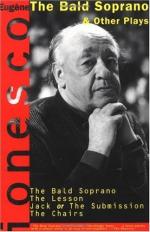|
This section contains 345 words (approx. 1 page at 400 words per page) |

|
The Bald Soprano Summary & Study Guide Description
The Bald Soprano Summary & Study Guide includes comprehensive information and analysis to help you understand the book. This study guide contains the following sections:
This detailed literature summary also contains Bibliography and a Free Quiz on The Bald Soprano by Eugène Ionesco.
In 1948, Eugene Ionesco began writing The Bald Soprano, as he later confessed, almost in spite of himself, for by that tune he had come to despise the theater that he had much loved in his youth. What did intrigue him was the banality of the expressions used in an English-language phrase book. These phrases were the inspiration for this anti-play or parody, "a comedy of comedies." Although he set out to show how human discourse had devolved into a collection of empty platitudes and self-evident truisms, something that he believed was very distressing, his friends found his play very amusing, and they encouraged him to find a theater that would stage it One of these friends, Monique Saint-Come, showed the work to Nicolas Bataille, the director of a group of avant-garde actors working in Paris.
It was under Bataille's direction that La Cantatrice chauve was first produced in French at the Theatre des Noctambules in Paris on May 11, 1950. In rehearsal, the company had first tried staging the play as parody but had soon discovered that it worked best if presented as wholly serious drama, in the realistic mode of Ibsen. They had also experimented, trying several different endings, for example. Essentially, even after it opened, La Cantatrice chauve remained a work in progress.
The first staging was poorly received. Only the dramatist Armand Salacrou and the critic Jacques. Lemarchand praised it. However, the negative responses mattered little to Ionesco, who "suddenly .. . realized that it was his destiny to write for the theatre." He began a series of "anti-plays" that within a decade established his place in the new French theater, the group of avant-garde playwrights that included Samuel Beckett, Arthur Adamov, and Jean Genet. In the 1950s, La Canta-trice chauve was translated into various languages and widely staged; by 1960, in the United Stales, where it had been translated and produced as The Bald Soprano, it was already being recognized as a modern classic, an important seminal work in the theater of the absurd, which by then was first coming into vogue in America.
Read more from the Study Guide
|
This section contains 345 words (approx. 1 page at 400 words per page) |

|



